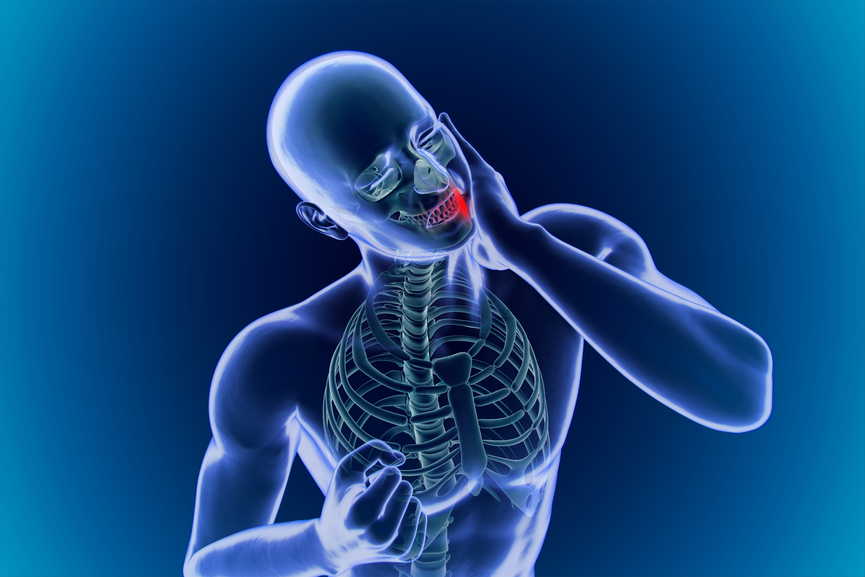Understanding Jaw Pain & TMJ Syndrome, Diagnosis, and Treatment

Get jaw & TMJ pain relief with Good Life Chiropractic in Campbell CA 95008
TMJ Dysfunction (Temporo-Mandibular Joint Dysfunction) is a cluster of symptoms associated with the jaw joint that causes jaw pain.
The name indicates the joint formation via the mandible and the temporal bones of the head.
The joint has a cartilaginous disc between its articulation that may be injured during biting, trauma (e.g., severe whiplash injuries or blow to the mandible), or slow chronic teeth grinding.
"Using the Activator Method and only two visits...I was pain free..." - Dr. Sun
Although joint pain is usually considered very benign, the consequences of TMJ Syndrome can be very difficult. Unfortunately, in some cases, TMJ Syndrome can last for years.

Jaw pain is no fun, but pain relief can be had
And, due to inconclusive treatment protocols and lack of research, many patients seek help from doctor to doctor with minimal relief.
We're Accepting New Patients!
Se Habla Español
Dr. Sun's training in TMJ Syndrome treatment started in 1989 when he faced the disease.
Due to the severe stress of clinic entrance exams at Palmer Chiropractic College, Dr. Sun, then a student at the school, noticed severe jaw pain, which forced him into liquid diets for weeks.
Finally, out of sheer desperation, I consulted one of his adjustment instructors and asked for help.
Using the Activator Method and only two visits, Dr. Sun indicates, "I was pain-free with immense interest in treating this debilitating disease."
Finding the Cause(s) of Jaw Pain
A good practitioner must diagnose jaw pain by finding the core cause of the disease.
The patient must be evaluated for any arthritic diseases, hereditary possibilities, traumas to the neck and face such as car accidents or sports injuries, bite or dental issues, and grinding of teeth such as bruxism.
TMJ Syndrome is diagnosed when pain, lack of mobility, or noise, such as popping sounds present during normal jaw function.
About 20 to 30% of adults are affected by this disease, and most of the patients are females.
We're Accepting New Patients!
Se Habla Español
Treatment For TMJ Syndrome
- Decreasing TMJ inflammation
- Decreasing joint fixation using gentle and pain-free chiropractic adjustments
- Improving bilateral muscle balance using specific jaw exercises to retrain the involved muscles
- Improving jaw muscle tonicity by using specific TMJ exercises
- Treating the cervical spine (neck) is involved in the TMJ Syndrome
- Possible referral to a dentist for occlusal adjustment (bite adjustment)
- In severe cases where medical intervention is needed, the patient may be referred for more invasive treatments such as injecting anti-inflammatory in involved soft tissue or using botox injections to relax the involved muscle
What To Do...
If you are suffering from TMJ Syndrome or think you may be having some jaw discomfort, feel free to call our office for a quick evaluation of your condition.
Such diseases should be treated using conservative methods before any invasive procedures are utilized.
The jaw joint is incredibly sensitive, and lack of ease in this joint can decrease the quality of life.
Pain during eating, pain at night during sleeping, and jaw pain at work due to stress can be fatiguing.
The sooner you seek help the better your chances of you being able to beat this disease.
I look forward to helping you get relief from your jaw pain, including TMJ pain.
We're Accepting New Patients!
Se Habla Español
Jaw & TMJ Pain FAQs
Q - What causes TMJ pain?
A - TMJ pain can result from various factors including misalignment of teeth, stress, poor posture, arthritis, excessive gum chewing, teeth grinding at night, injury, and certain diseases. However, often it's a combination of factors that lead to TMJ pain.
Q - How can a chiropractor help alleviate my TMJ pain?
A - Chiropractors can help alleviate TMJ pain by working to correct any misalignments in your jaw and neck, reducing muscle tension, and improving nerve function. Additionally, they can provide you with exercises and lifestyle advice to help manage your symptoms and prevent further issues.
Q - Are there any risks or side effects associated with chiropractic treatment for TMJ?
A - Chiropractic care is generally considered safe, but as with any treatment, there can be potential risks or side effects, including temporary soreness or discomfort. However, these are typically mild and short-lived. Always discuss any concerns with your chiropractor prior to treatment.
Q - What other therapies or treatments can I use in conjunction with chiropractic care to manage my TMJ pain?
A - In addition to chiropractic care, other strategies can help manage TMJ pain, including heat/cold therapy, massage, stress management techniques like yoga or meditation, wearing a dental splint or mouth guard at night if you grind your teeth, and physical therapy exercises.
Q - How many treatments will it take before I see improvement in my TMJ pain?
A - The number of treatments needed can vary greatly depending on the severity of your symptoms, the exact cause of your TMJ pain, and your body's response to treatment. It's essential to have this conversation with your chiropractor, who will provide a treatment plan tailored to your needs.
#jawpain #tmjsyndrome
